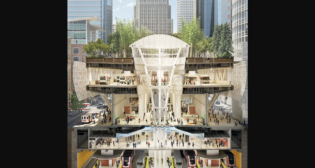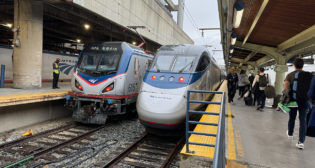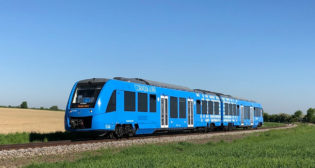
Amtrak looks to new NEC trainsets
Written by William C. Vantuono, Editor-in-Chief“In early 2013, Amtrak will issue a Request for Information (RFI) to formally start the process that will replace the existing 20 Acela Express trainsets and procure additional trainsets to expand seating capacity and provide for more frequent high-speed service on the NEC,” Boardman said. “Moving directly to new high-speed trainsets is the best option to create more seating capacity, permit higher speeds, and maximize customer comfort, all while improving equipment reliability and reducing operating costs. The previous plan to add 40 new passenger cars with newer technology to the older Acela trainsets was a stopgap measure, posed technical challenges, and was determined not to be cost effective and insufficient to handle new ridership growth projections”
Boardman said that, in the past two years, “Amtrak has moved forward a number of major proposals designed to address the NEC’s growth and development needs. First is the NEC Upgrade Program to bring the corridor up to a state of good repair, add additional capacity to allow limited service growth, and make targeted trip-time improvements for all existing intercity, commuter, and freight services. Among the elements is the Gateway Program to build vital track, tunnel, and station capacity into the heart of Manhattan to support Amtrak and commuter rail growth.
“Second is the next-generation high-speed rail program to provide America’s economic, political, and cultural capitals in the Northeast with the world-class 220 mph high-speed service the region deserves. With possible operating profits over a billion dollars annually and ridership well into 40 million riders a year upon full buildout, Amtrak expects that private capital, probably in the form of a public-private partnership, could play a significant role in this project.”
Boardman noted that Amtrak’s proposals are detailed in the Amtrak Vision for the Northeast Corridor 2012 Update Report.
Boardman said that “only after the public sector has allocated significant funding and committed itself to a project of this magnitude that the private sector is willing to enter the deal and deliver value for money. Once these services are generate revenue streams, these projects can and will attract private funding that can help repay initial capital costs.”
The hearing—the final full T&I Committee hearing of the 112th Congress—was led by outgoing Chairman John Mica (R-Fla.), who over the years has been one of Amtrak’s harshest critics, as well as a critic of the Obama Adminstration’s high speed rail program. Mica, using oft-repeated rhetoric, issued a statement following the hearing in which he said that “NEC high-speed rail development has had a problematic history and it has been a squandered asset for too long. In fact, Committee Republicans highlighted the underutilization of the NEC in their ‘Sitting On Our Assets’ report in October 2010. Amtrak’s acquisition and use of the Acela has been plagued with problems, and while true high-speed rail averages a minimum of 110 miles per hour, Acela averages only 83 miles per hour between D.C. and New York and only 72 miles per hour between New York and Boston. High-speed rail in the NEC makes sense if done properly. There has been some recent progress. The NEC was finally designated a high speed corridor, an environmental review is under way, and the NEC Advisory Commission is moving forward in its planning. However, Amtrak’s $151 billion, 30-year plan is simply too much money and too long, and we must bring in the private sector if NEC high speed rail is going to become a reality.”
Continuing on his private-sector-funding push, Mica (misnaming New York’s Grand Central Terminal), touted, “I began my Chairmanship this Congress with a hearing in Grand Central Station on the need for private sector involvement in developing Northeast Corridor high speed rail, and with today’s final scheduled Full Committee hearing of the Congress, we’ll examine the issue again nearly two years later. While I have been a vocal critic of Amtrak, I am also a strong proponent of high speed rail, passenger rail, and transit. But we have to ensure that any rail development or project makes sense, in places where there is the greatest need and at the lowest possible cost to the taxpayers.”



